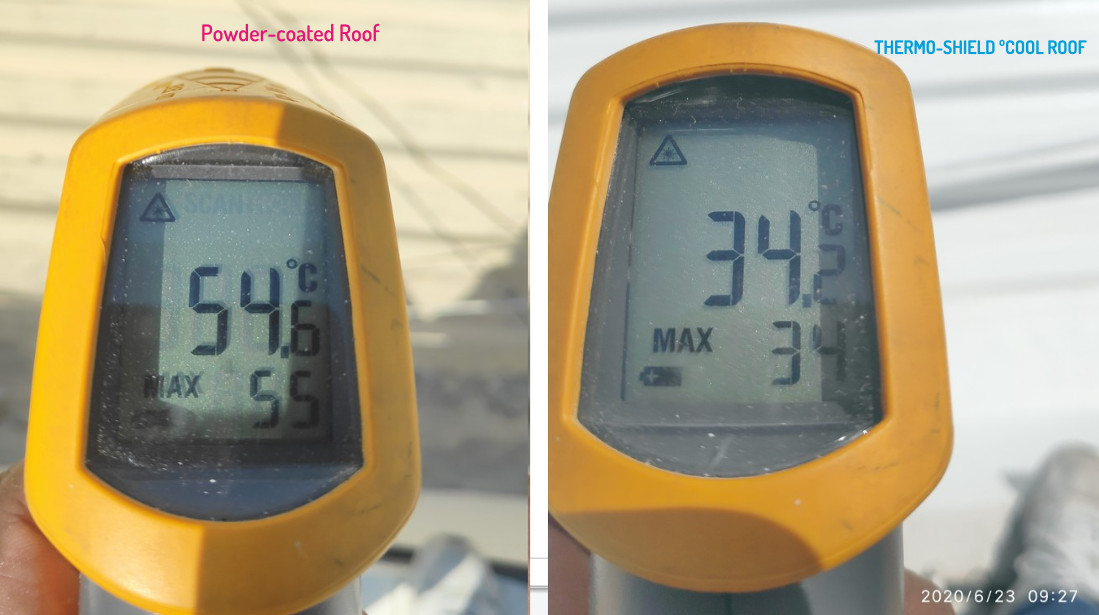Energy Saving °Cool Roofs by Thermo-Shield
Thermo-Shield Cool Roof Coats provide high Solar Reflectance Index values 110/99, helping negate Solar Heat Gain. No cool roof coat is a direct replacement for conventional bulk insulation like PU foam, Polystyrene, Rock Wool etc – as claimed by many roof coat manufacturers. The post on Energy Savings explains more about 'R' and 'U' values.

This roof is of a private villa in Sharjah, UAE. The time is 09:27am on 23rd June, 2020. The Arabian Summer sun is not blazing hot yet, the surface temperature difference is pretty remarkable.
Urban Heat Islands
Roof temperatures in the UAE can easily touch as high as 80 °Ceslius at around TWO in the afternoon. Air temperatures do go up to 50 ° and above. Roofs, buildings, roads and pavements, sidewalks and footpaths all soak in the sun's rays. The phenomenal heat then goes on to heat the surrounding air. The Air-conditioners and chillers then struggle to cool down this extremely hot air – consuming more energy – increasing carbon emissions. Urban Heat Islands do contribute a great deal to global warming or if you prefer to call the sanitized version: climate change. Cool Roofs reduce the roof temperatures, thus reduce Urban Heat Islands. If the Air Temperature is 50 °C, a Thermo-Shield applied roof will be as hot or cold as the Surrounding Air - which is 50 °C. The uncoated mill-finish metal roof or a bitumen-applied black roof will be hovering around 80 °C.
Solar Reflectance Index
There are so many 'Insulation Coatings' in the market, and they claim magical powers. Over the years I have seen plenty of brochures and flyers which claim the 'Insulation Coatings' function better than a PU Foam Insulation. There are companies who sell these magical powder – 'Paint Additives' in cans and pouches. Laws of Physics do not change overnight. These 'paint additives' are nothing other than borosilicate glass bubbles.
There is a science to Cool Roofs and it is not known as Paint Additives or Glass Bubbles, it is called "Solar Reflectance Index."
The Solar Reflectance Index (SRI) is a measure of the roof's ability to reject solar heat, as shown by a small temperature rise. It is defined so that a standard black (reflectance 0.05, emittance 0.90) is 0 and a standard white (reflectance 0.80, emittance 0.90) is 100. For example, the standard black has a temperature rise of 90 deg. F (50 deg. C) in full sun, and the standard white has a temperature rise of 14.6 deg. F (8.1 deg. C). Once the maximum temperature rise of a given material has been computed, the SRI can be computed by interpolating between the values for white and black.
Solar reflectivity expresses the degree to which a roof reflects the visible, infrared and ultraviolet rays that comprise solar energy. Surfaces with high solar reflectivity reflect more infrared and ultraviolet rays.
Infrared emissivity refers to the roof's ability to give off its absorbed heat. Highly emissive surfaces are cooler than non-emissive surfaces since they have the ability to shed more absorbed heat at a faster rate.
The Cool Roof website is a great source to learn more about SRI.

